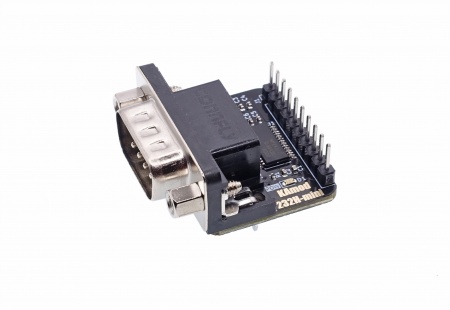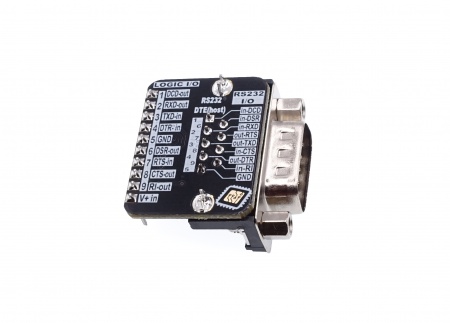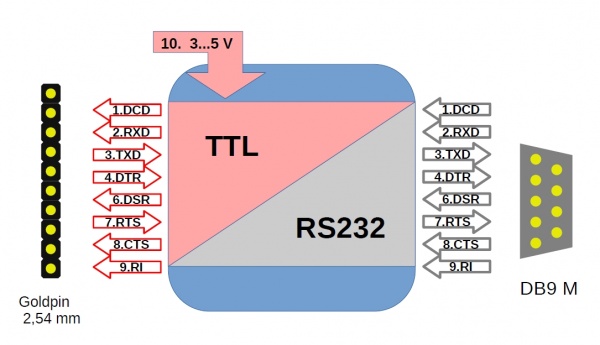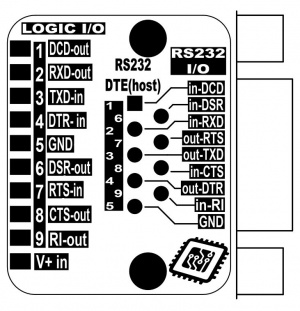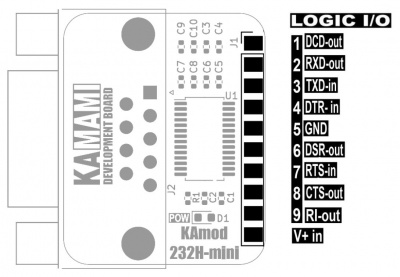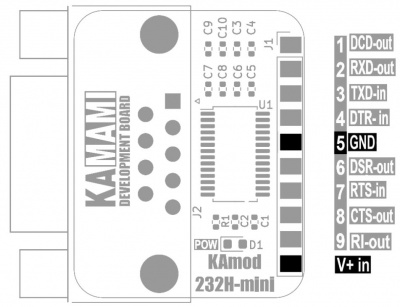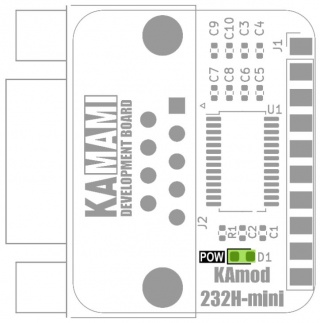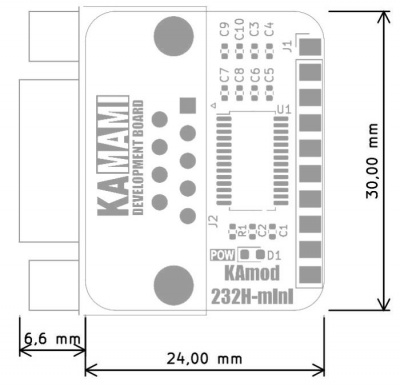KAmod RS232H-mini
From Kamamilabs.com - Wiki

Description
KAmod RS232H-mini is a miniature RS232 to TTL converter that contains all RS232 interface signals: RXD, TXD, DTR, DSR, RTS, CTS, DCD and RI. The direction of signal conversion is assigned in such a way that it corresponds to the DTE/Host type device (master device, TXD is the RS232 signal output, RXD is the RS232 signal input). The converter has a typical DB9 male connector on the RS232 side and 2.54 mm goldpins on the TTL side. It can operate at a voltage of 3...5.5 V.
Basic parameters
- RS232 to TTL standard converter, containing all 8 signals
- Based on MAX3243/SP3243
- Voltage on the TTL side 3...5.5 V
- Maximum transmission speed: 250 kbps
- ESD protection up to 15 kV HBM on the RS232 side
- Signal conversion direction assigned in such a way that it corresponds to the master device, type DTE/Host (TXD is RS232 output, RXD is RS232 input)
- Standard DB9 connector (D-SUB 9) male
- 2.54 mm goldpins on the TTL side for easy connection to evaluation boards
- Power supply 3...5.5 V, approx. 20 mA
- Board dimensions 24x30 mm (31x30 with DB9 connector), height approx. 17 mm
Standard equipment
| Code | Description |
|---|---|
| KAmod RS232H-mini | Assembled and launched module |
Electrical diagram
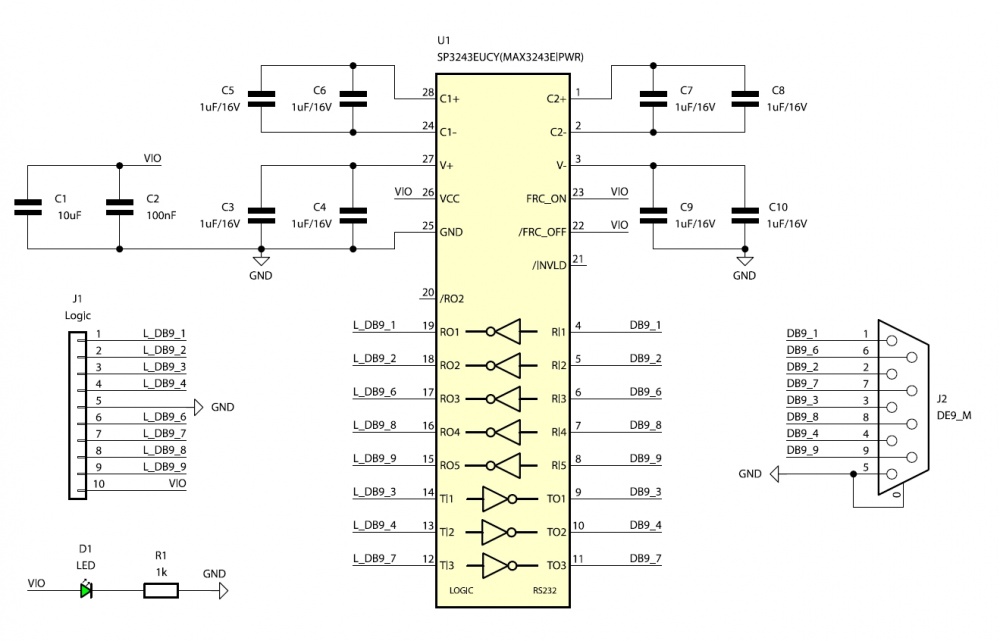
Functional diagram
The RS232 standard is used for digital communication in serial mode, and because in addition to the data transmission line it contains lines for controlling and controlling communication, it provides a stable connection resistant to interference. The voltages on the RS232 interface lines have values from ±7 V to ±15 V, therefore connection to a classic TTL digital system, whose signals take values of 0/3.3 V or 0/5 V requires the use of an appropriate converter, such as KAmod RS232H-mini.
The direction of signal conversion for all 8 signals is assigned in such a way that it corresponds to the master device - DTE/Host. The functional diagram shows which signals act as inputs and which as outputs on the TTL and RS232 sides.
On the converter board, on the lower description layer, there are precise markings for each signal on each connector:
TTL connector (LOGIC I/O)
| Connector | Function |
|---|---|
| LOGIC I/O
1x10 goldpin pins, 2.54 mm |
|
The LOGIC I/O connector allows you to connect the KAmod RS232H-mini converter with any digital system operating with a voltage of 3...5.5 V. The functions of the individual pins are as follows:
- pin no. 1 - TTL output; DCD signal - Data Carrier Detect (signal detecting the carrier wave by the modem);
- pin no. 2 - TTL output; RXD signal - Receive Data Line (data stream received from RS232, sent to DTE/Host);
- pin no. 3 - TTL input; TXD signal – Transmit Data Line (data stream input from DTE/Host);
- pin no. 4 - TTL input; DTR signal – Data Terminal Ready (readiness of DTE/Host for further cooperation with DCE/Modem);
- pin no. 5 - ground, GND;
- pin no. 6 - TTL output; DSR signal – Data Set Ready (readiness of DCE/Modem for further cooperation with DTE/Host);
- pin no. 7 - TTL input; RTS signal – Request To Send (request to transmit data reported by DTE/Host);
- pin no. 8 - TTL output; CTS signal – Clear To Send (readiness to transmit reported by DCE/Modem - confirms receipt of RTS signal);
- pin no. 9 - TTL output; RI signal - Ring Indicator, a "ringing" signal generated from the modem;
- pin no. 10 - 3...5.5 V power input.
DB9 type RS232 connector
| Connector | Function |
|---|---|
| DB9 (D-SUB 9) |
|
The DB9 RS232 connector, also known as D-SUB 9, is a typical connector used forimplementation of the RS232 interface. The DTE device, i.e. the master device (most often this role is played by a PC), is equipped with a male DB9 connector. The KAmod RS232H-mini converter also has a male connector.
The functions of the individual connector pins are as follows:
- pin no. 1 - RS232 input; DCD signal - Data Carrier Detect (signal that the modem detects the carrier wave);
- pin no. 2 - RS232 input; RXD signal - Receive Data Line (received data stream, sent from DCE/modem);
- pin no. 3 - RS232 output; TXD signal - Transmit Data Line (data stream from DTE/Host);
- pin no. 4 - RS232 output; DTR signal – Data Terminal Ready (readiness of DTE/Host for further cooperation with DCE/Modem);
- pin no. 5 - ground, GND;
- pin no. 6 - RS232 input; DSR signal – Data Set Ready (readiness of DCE/Modem for further cooperation with DTE/Host);
- pin no. 7 - RS232 output; RTS signal – Request To Send (request for data transmission reported by DTE/Host);
- pin no. 8 - RS232 input; CTS signal – Clear To Send (readiness to transmit reported by DCE/Modem - confirms receipt of RTS signal);
- pin no. 9 - RS232 input; RI signal – Ring Indicator, a "ring" signal generated from the modem.
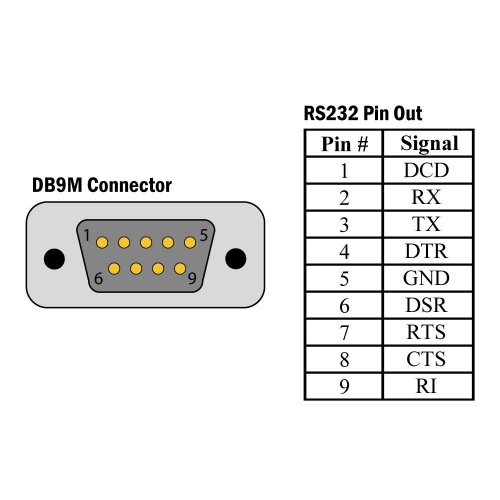
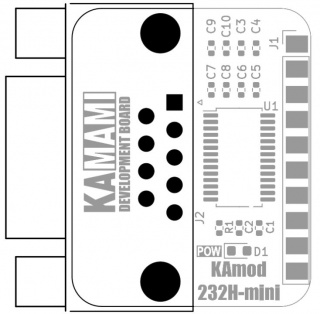
Power
| Connector | Function |
|---|---|
| LOGIC I/O
Goldpin pins 1x10, 2.54 mm |
|
The LOGIC I/O connector contains pins that connect the power supply to the KAmod RS232H-mini converter
- pin no. 5 – ground, GND;
- pin no. 10 – VIO; voltage input from the range of 3...5.5 V, which will correspond to logical "1" for all signals on the LOGIC I/O connector.
Power signaling
| TYPE | Function |
|---|---|
| POW
LED diode |
|
The LED diode marked POW signals the presence of the converter's power supply voltage.
Dimensions
The dimensions of the KAmod RS232H-mini converter are 24x30 mm boards (31x31 with the DB9 connector). The module height is approx. 17 mm.
